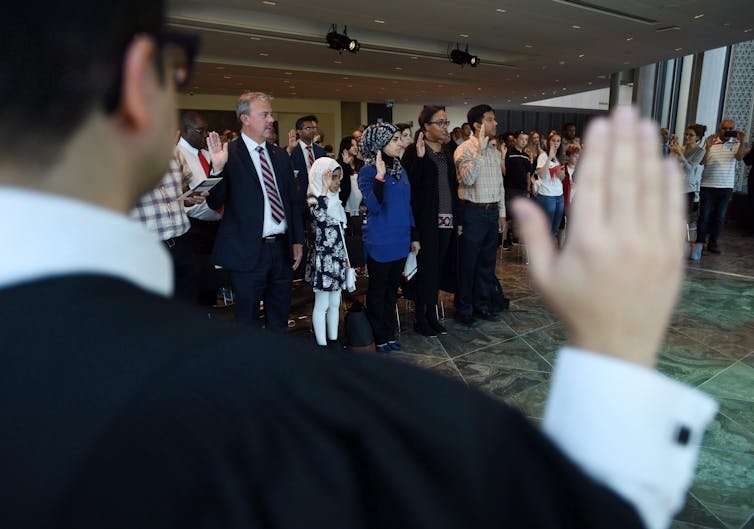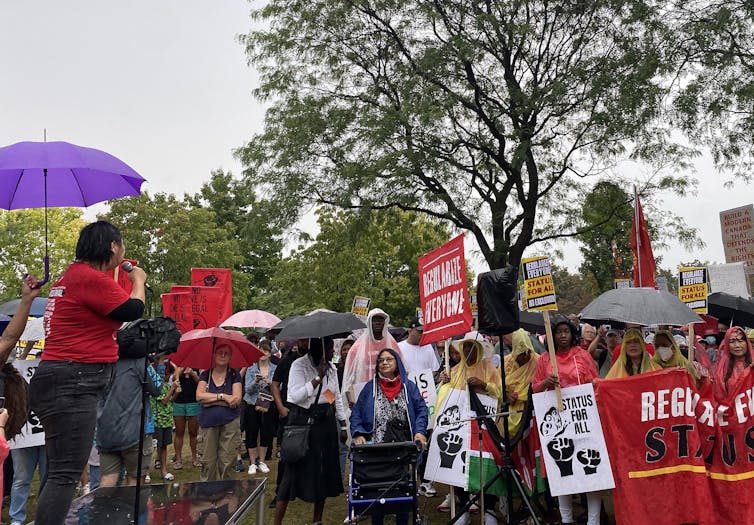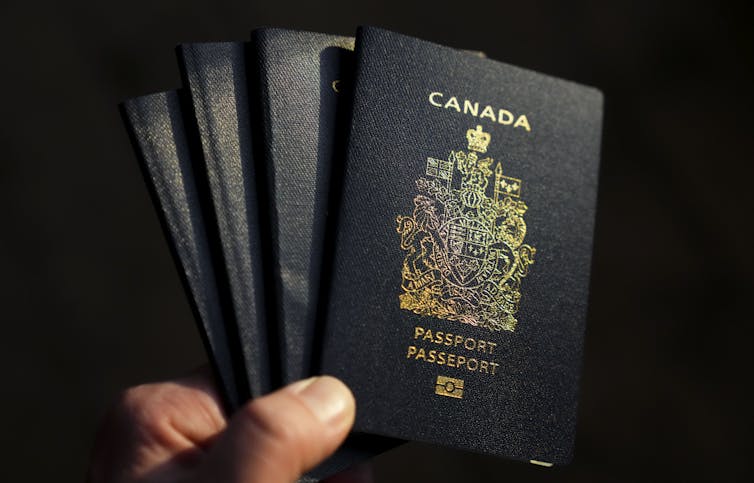John Carlaw, Toronto Metropolitan University
A recent press release from the Institute for Canadian Citizenship that cites Statistics Canada data has highlighted concerns over a 40 per cent reduction in Canada’s “naturalization rate” — the rate at which permanent residents are becoming citizens.
The release, headlined Newcomers falling out of love with Canadian citizenship generated a number of other media headlines.
Concerns over how and whether those living and working in Canada are attaining citizenship and important rights — including to vote and run for office — are of course well placed. But love of country by immigrants is not the primary problem.
Individual choices and sentiments are a relevant factor, but there are observable structural explanations. Beyond Canada’s control, not all countries permit dual citizenship. That includes major source countries China and India where many immigrants to Canada are from. It is understandable that some permanent residents prefer not to renounce the citizenship of their country of origin.
But within Canada’s control, there are troubling shifts in our overall citizenship and immigration model. Inequalities connected to its colonial nature have left growing numbers of residents without citizenship or even a pathway to it.
Annual immigration levels, for example, only represent those accepted as permanent residents and obscure the number of those admitted to Canada under less secure conditions.
This has occurred thanks to under-discussed but at times controversial shifts from permanent to temporary or multi-step migration.
These shifts can be obscured by focusing primarily on the naturalization process and the sentiments some attach to it rather than the larger settler colonial landscape of migration and immigration and its relationship to citizenship and belonging at each stage.

Unkept promises and unlearned lessons
In recent years, Canada has apologized for past discriminatory immigration measures and its treatment of Indigenous Peoples. And there have been recent symbolic advances recognizing First Nations, Inuit and Métis communities and Canadians’ treaty responsibilities in the citizenship oath.
However, social exclusions in modern forms related to the project of Canadian nation-building, citizenship and belonging persist. They are even intensifying in important respects.
A recent report from the Yellowhead Institute found that, despite an expressed commitment to fully implement the Truth and Reconciliation Commission’s 94 Calls to Action, the Federal government has only fulfilled 13, with those providing symbolic rather than structural remedies.
This example is indicative of why many Indigenous people — themselves denied the vote for much of Canada’s history — understandably view Canadian citizenship as, at best, a “kinder, gentler form of colonialism.”
These realities also remind us that the terms and hierarchies of citizenship and societal membership in Canada shift over time. They are subject to social struggle. And apologies and symbolic advancements do not relegate mistreatment to the past.
Hierarchies of belonging persist
“White Canada” immigration policies that favoured European immigrants and largely excluded those from elsewhere were in place until the 1960s.
These entrenched institutional and demographic dominance by white settlers. Europeans immigrating to Canada in earlier periods had ready access to permanent residence and eventual citizenship, unlike many of their contemporary racialized counterparts.
Institutional racism continues to be felt in the country’s immigration system and political life as tiers of citizenship and belonging continue to be practiced in old and new forms.
Canada adopted official multiculturalism in 1971, yet two years later it entrenched migrant worker programs, primarily for racialized workers from the Global South. As with past exclusions, these workers still have to navigate programs and realities that prevent or make it difficult for them to access permanent residence and citizenship.
This is particularly the case for those working in what are deemed to be “low skill” positions. Many such workers become “permanently temporary” despite ongoing demands for their labour.
Today, Canada’s political institutions are still disproportionately composed of men of primarily European descent. And they continue to set and enforce problematic terms of citizenship and societal membership.
Today’s more difficult pathways to citizenship
Today’s immigrants — who mostly come from the Global South — face a system of complex chutes and ladders when it comes to their status in Canada. That system leads many migrants to remain stuck in an immigration purgatory, far away from pathways to permanent residence, let alone citizenship.
Even those often characterized as the perfect immigrants — international students who pay vast sums that subsidize our post-secondary education system — face limited and precarious pathways to permanent residence and citizenship.
As economist Armine Yalnizyan recently noted, today for each person granted the security of permanent residence, there are two migrant workers or international students who have uncertain or no access to permanent status.
This could prove an obstacle to attracting and retaining workers. When it comes to citizenship and societal membership, it hinders inclusion by creating an exploitable class of workers who lack full political and social rights.
In the face of these realities, many migrants, students and workers are mobilizing to address these exclusions. This includes protests in several cities demanding “status for all” to mark the International Day for the Elimination of Racial Discrimination.

To return to the later stages of the process of becoming Canadian by adopting citizenship, under the former Conservative government, citizenship became harder to get and easier to lose by design.
Unfortunately, amidst the last decade’s battles between more exclusionary Conservative and rhetorically warmer Liberal visions of citizenship, tougher and more expensive procedures than previously existed remain under both.
The costs of applying for citizenship increased significantly under the Conservatives, and have remained prohibitive for many. The Trudeau government has made some positive reforms, such as reversing changes that made it take longer to become a citizen. But it has failed to follow through on its election promises to eliminate citizenship fees.
One recent study argues that it is likely that fee hikes and tougher, often expensive language requirements negatively impact a significant number of applicants.
Even those who have managed to obtain permanent residency and fulfilled their residency requirements face further “boundaries related to management flaws, classed naturalization, and cultural biases.” That means many, particularly refugee claimants and family class immigrants, struggle with the citizenship process.
For those who can reach the end of the process, some find it distasteful to continue to have to declare an enforced oath to a colonial figure, a reminder of the structures and hierarchies discussed in this article.
Given this context, the significant decline in Canada’s naturalization rate should be less surprising, though no less alarming as Canada continues to foster and even intensify inequalities of societal membership in its citizenship and immigration regime.![]()
John Carlaw, Postdoctoral Research Fellow under the Canada Research Chair (CERC) in Migration and Integration Program, Toronto Metropolitan University
This article is republished from The Conversation under a Creative Commons license. Read the original article.



